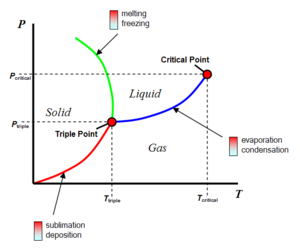Difference between revisions of "Sublimation"
(addition) |
(→External links: added link) |
||
| Line 6: | Line 6: | ||
During the Martian winter CO<sub>2</sub> frost is deposited at the winter pole. During the Martian summer CO<sub>2</sub> ice sublimes from the summer pole. | During the Martian winter CO<sub>2</sub> frost is deposited at the winter pole. During the Martian summer CO<sub>2</sub> ice sublimes from the summer pole. | ||
| + | |||
| + | ==See also== | ||
| + | *[[Martian features that are signs of water ice]] | ||
[[category:climate]] | [[category:climate]] | ||
[[category:physics]] | [[category:physics]] | ||
Revision as of 10:18, 10 May 2018
Sublimation is the phase transition between solid and gas, without an itermediate liquid phase. As the pressure and temperature of Mars is very low, water on the surface can only exist as ice or water vapour. In the phase diagram for water on Mars, temperatures and atmospheric pressure are below the triple point.
Sublimation occurs when ice is heated. A terrestrial example of sublimation is if "dry ice" (solid CO2) is exposed to air at one atmosphere. The ice will turn into a gas and appear to steam without passing through a liquid phase. The opposite to sublimation is deposition, where water vapour is cooled and deposited as ice. An example of deposition is terrestrial frost, where water vapour (during winter) becomes very cold, bypassing the liquid (rain) phase.
During the Martian winter CO2 frost is deposited at the winter pole. During the Martian summer CO2 ice sublimes from the summer pole.







